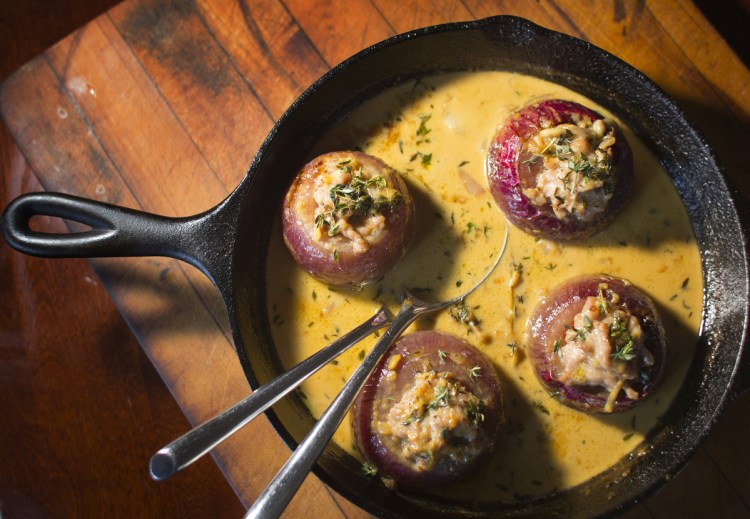The onion is often held up as a metaphor for life. You know, all of those layers that need to be peeled back to expose a sweet or a sulfuric inner essence depending whether you’re quoting Steve Jobs or Carl Sandburg. But take a moment, please, to consider the onion as an encapsulation of the issues with and the answers for making your personal eating habits more sustainable over time.
Consider, first, the onion’s ubiquity. In “Cooked: A Natural History of Transformation,” writer Michael Pollan points out that almost every stew recipe around the world starts with onions. Onions, carrots and celery softened in butter is French mirepoix. That trifecta with olive oil as the fat in play is Italian soffritto. Drop one “t,” swap the carrots for tomatoes and you’ve moved over to Spain. The holy trinity of Cajun cooking comprises onions, celery and bell pepper. In parts of the Far East, the base aromatic combination is spring onions, garlic and ginger. Indian stews start (and often end) with tarka, onions and spices sautéed in ghee. The basis of most West African cuisines is a trio of onions, chili peppers and tomatoes.
“It’s hard to imagine a civilization without onions,” Julia Child wrote in “Mastering the Art of French Cooking.”
According to consumption rates tracked by the United Nations’ Food and Agriculture Organization, onion production stands at 105 billion pounds each year. The average annual onion consumption weighs in at almost 14 pounds per person across the world. Americans consumed far more than that last year, about 22 pounds each, says the USDA.
So what’s the problem? In part, it’s geographic. The top three onion-producing areas in the United States are California, Idaho-Eastern Oregon and Washington state. Additionally, according to the National Onion Association, the United States imports between 16 and 20 million 50-pound bags of onions annually from Mexico, Canada, Peru and Chile. With the exception of parts of Canada, those areas – you don’t need me to tell you – are a long way from Maine. And moving food across the country and across the globe has high environmental costs.
Fortunately, this is an issue you can easily solve for yourself by buying local onions.
Tom Roberts has been enthusiastically growing shallots, sweet onions and storage onions for 35 years on Snakeroot Organic Farm in Pittsfield. He explains that when the bulbous onions growing underground reach a harvestable size, the green stalks above ground weaken and tip over, a signal for the farmer to pull the bulbs from the soil.
Before they can go into storage without fear of rotting, the onions must cure for several days in the field, followed by several weeks in a dry, sunny area. In Maine, the fall rains complicate that curing schedule for any farmers who want to grow a large commercial harvest, Roberts said.
But you can buy good local onions from Maine farmers on a smaller scale, he said, guessing that farmers in most counties in Maine can grow at least some supply.
Never buy a dirty onion, though, Roberts cautioned. If an onion is cured properly, the outer layer that came in direct contact with the soil will have been easily sloughed off before the farmer brought it to market. If it’s still got that soiled outer layer, it hasn’t been cured properly and won’t store well when you bring it home, he said.
Waste is another key issue when it comes to onions – or really any food. The National Resource Defense Fund (NRDC) began raising public awareness in 2012 about the fact that over 40 percent of the food that enters the food supply chain gets wasted, and it set a goal of cutting food waste in half by 2030. So let’s do a little math: Take that 22 pounds of onions that Americans eat annually. Learn that roughly six small onions make up a pound, which, in turn, means that on average every American eats a third of a small onion every day. If we’re wasting 20 percent of that allocation, we’re each wasting two onions per month.
It’s needless.

Sausage-stuffed Onions gives the onion a starring role on the dinner plate.
Dana Gunders, a former NRDC employee and author of “The Waste Free Kitchen Handbook,” says onion conservation in your own kitchen starts with proper storage. Store them in a cool, dark, dry place far away from your potatoes (or they will stimulate the spuds to sprout). It’s best to store them in a hanging cloth sack (never plastic) to encourage good ventilation. Check often and remove any molding onions or they’ll trigger others to mold.
Partially used onions should be stored, skin-on, in an airtight container in the refrigerator. If you’ve already peeled it and don’t need the leftover onion right away, chop it, freeze it raw and use it next time you cook a dish that requires chopped onions.
Here are some other tips from Gunders:
• Onions sprouting green tops are still safe to eat. Remove the sprouts, use them as you would scallions and peel the onion as usual.
• If the outer layers of an onion are bruised and rotten, peel them away until you get to a pristine layer and compost the rotten ones.
• The sliced-off ends of an onion work well to flavor a pot of beans.
• The peels of a yellow onion will give your stocks a golden hue.
Gunders also suggests that a sliced-off root end of an onion can be planted to grow another hyper-local one in your own garden.
ABOUT THE WRITER
CHRISTINE BURNS RUDALEVIGE is a food writer, recipe developer and tester and cooking teacher in Brunswick, and the author of “Green Plate Special,” a cookbook from Islandport based on these columns. She can be contacted at cburns1227@gmail.com.
Send questions/comments to the editors.


